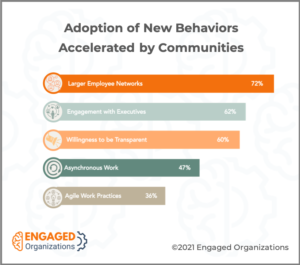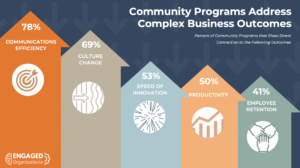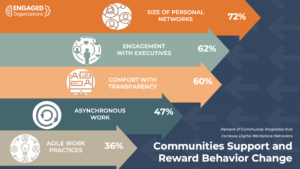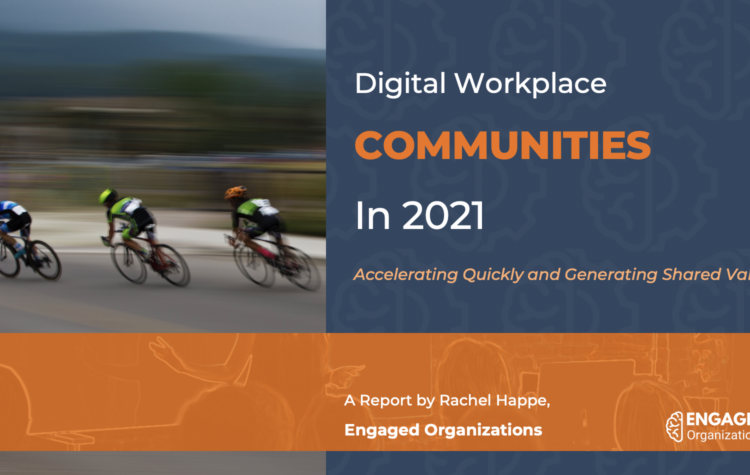 Every organization is scrambling to figure out what the new ‘normal’ looks like and in different phases of building a hybrid workplace. Will everyone be remote most of the time? Will employees be required to return to offices? Something in-between? If so, what does THAT look like?
Every organization is scrambling to figure out what the new ‘normal’ looks like and in different phases of building a hybrid workplace. Will everyone be remote most of the time? Will employees be required to return to offices? Something in-between? If so, what does THAT look like?
It’s not an easy thing to navigate, especially with Gallup data showing that 48% of America’s working population is actively seeking jobs – and the motivation is not primarily about salary, but about how they feel about their workplace. A lot of the tools that HR currently has at its disposal, however, don’t fundamentally address this. Giving employees a sense of belonging and meaning is a management and culture issue. While policies influence culture, these issues are not ones that extra financial incentives, benefits, and comfortable office space will address. It is an ambiguous issue and one many HR teams cannot fully address.
Adding to the issue is an implicit responsibility for employees to solve their own communications challenges. However, because of the network effects of communications channels, it is impossible for an individual to solve a networked problem. Yet, organizations have largely abdicated responsibility for systematically addressing employee communications and work behaviors, assuming individuals or managers can figure it out.
Online Communities ARE the Hybrid Workplace
As organizations move to hybrid models, the biggest challenge is finding a common place for employees to aggregate, collide, discover what the rest of the organization is up to, and share what they are learning and experiencing. This challenge is not new; for global companies they have always had ‘hybrid’ work environments created by an array of regional offices, field employees, and headquarters each with their own culture and work habits. Those disparate cultures have created challenges in fostering alignment and innovation.
Online community ecosystems are a powerful way to centrally surface the work of organizations and make it transparent, accessible, and discoverable for all employees. Consolidating information in an open ecosystem not only allows for a diversity of hybrid work models, it creates a more inclusive and equitable workplace because more employees have ready access to the organization’s expertise, leadership, and conversations.
Yet today, organizations are almost exclusively focused on team level communications as they learn how to make remote work effective. While team chat and collaboration tools are critical for remote teams, they can also contribute to even more information silos. For managers and executives, their work has become even more consuming as they try to bridge these new divides and coordinate across their organizations.
As organizations invest to make hybrid work easy, efficient, and effective they will need solutions that help employees participate seamlessly and regularly beyond their teams to explore and connect to others with shared interests, challenges, expertise, or objectives. Online community networks offer this web of connection and act as the arteries by which employees can find each other – but it cannot be done on group chat platforms, which are closed and invite-only spaces by default. Architecturally, community platforms are open and transparent by default and membership is opt-in so everyone has access, but they can choose how they want to engage. This open access is critical to reducing duplication, finding the most current expertise, and connecting with employees in other groups or locations – and it is vital for rapid innovation.

The Digital Workplace Communities report offers some tantalizing results from organizations that have built these virtual workplaces. By generating shared value – benefiting both the organization and its employees – communities create a compelling pull that energizes culture.
The Shared Value of Enterprise Communities
 The value generated by enterprise communities seems to be too good to be true. If I had not been producing the State of Community Management since 2009, I would also be suspicious. For most of that time, the enterprise community space has hobbled along. There have been some inspiring exceptions, led by insightful leaders at companies like EY, Bosch, BASF, International Committee of the Red Cross, Steelcase, Siemans, Microsoft, Pearson, Thorton Tomasetti, World Bank Group – but they are the exception. For organizations like these, 69% of community programs can connect their impact directly to culture change. 53% can connect their impact to increasing the speed of innovation. The success in addressing these strategic objectives suggests that community programs are one of the most effective means to address them.
The value generated by enterprise communities seems to be too good to be true. If I had not been producing the State of Community Management since 2009, I would also be suspicious. For most of that time, the enterprise community space has hobbled along. There have been some inspiring exceptions, led by insightful leaders at companies like EY, Bosch, BASF, International Committee of the Red Cross, Steelcase, Siemans, Microsoft, Pearson, Thorton Tomasetti, World Bank Group – but they are the exception. For organizations like these, 69% of community programs can connect their impact directly to culture change. 53% can connect their impact to increasing the speed of innovation. The success in addressing these strategic objectives suggests that community programs are one of the most effective means to address them.

These successful community networks also produce meaningful value for employees. 72% of enterprise communities increased the size of employee networks – a critical mechanism to facilitate alignment, professional development, and innovation. That alone is valuable, but they also foster higher engagement with executives, increased comfort with transparency, and they encourage asynchronous and agile work habits. By normalizing new behaviors, community programs change the way organizations work, improving value for the organization while improving the employee experience.
Community Platforms and Technology Are Not Enough
You might be thinking to yourself – my organization has a social intranet or a community platform and we see none of these results.
New tools applied to old work patterns may generate marginal value – but it won’t transform behavior and with it business models. Community platforms allow individuals to work transparently but few will do so until they feel psychologically safe, which is a management and leadership challenge, not a technical one. The more safe and validated they feel, the more they will share and the more insight is exposed. Working transparently is much less about how to do so and much more about power, relational, and social dynamics.
Community management is the emerging discipline focused on creating safe, comfortable, and playful cultures which reward sharing, asking questions, and working iteratively together. The responsibility for an organization’s culture has traditionally been implicit in leadership and most great leaders foster great cultures intuitively. The profession and discipline of community management has made this skill explicit, documented, and more easily learned.
The organizations that are generating these remarkable results have enterprise community programs. Enterprise community programs act as enablement teams, working with business groups to structure, manage, reward, and measure the governance of the group. These teams typically include leadership, technical, design, training, and knowledge management skills that together help to optimize environments in ways that encourage connection, belonging, trust, transparency, and innovation.
Enterprise community teams face many challenges. They are typically small with limited integration into the core operational and business processes of the organization. The greatest value of enterprise community programs is also the greatest challenge; communities effectively span organizational silos of all types and, because of that, there is no one organizational unit or budget in which these programs best fit. Most functional groups are not prepared to fund a program that ultimately serves the entire organization. Because of that, sponsorship and budgets have been hard to secure and are often funded by a senior executive’s discretionary budget, which is limited.
Our research shows powerful reasons to invest in an enterprise community team, charged with helping organizations use technology AND different management practices to foster trust and connection. Check it out –



